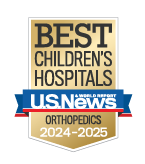Concussion Treatment
Nationally ranked by U.S. News & World Report

Concussions can happen during almost any sport. If you are concerned that your student-athlete has a concussion, they should be removed from play immediately and seen by a health care professional as soon as possible.
Certified concussion specialists
The team of board-certified sports medicine physicians at the Children’s Mercy Sports Medicine Center will perform a thorough evaluation and create a plan to help your student-athlete recover and get back to playing the sport they love.
All of our sports medicine physicians have specialized training in caring for high school and junior high athletes. As the only pediatric-specific Level I Trauma Center in the region, Children's Mercy has every specialist your student-athlete might need in one place. The concussion care team works alongside neurologists, neuropsychologists, rehabilitation medicine physicians, and neurosurgeons if your athlete needs additional care.
Sports physical therapists and athletic trainers with pediatric expertise will guide your student-athlete through a multi-step recovery process to safely return them to learning and athletic activities.
Concussion symptoms
Concussions can be caused by a bump, blow, or jolt to the head or body, or when an athlete simply trips or falls to the ground during a game.
The first step for any student-athlete with a suspected concussion should be immediate removal from play for the remainder of the day, and until cleared by a medical professional.
Recognizing the symptoms of concussion can help protect your student-athlete from further complications. Look for these immediate and longer-term symptoms of concussion:
Immediate signs of a concussion
Seek immediate medical attention if your student-athlete has any of the following symptoms:
-
Headache
-
Feeling of pressure in head
-
Neck pain
-
Nausea or vomiting
-
Dizziness
-
Blurred vision
-
Balance problems
-
Sensitivity to light
After-effects of concussion
These symptoms of concussion in children and adolescents frequently last up to three weeks. They include:
-
Sensitivity to noise
-
Feeling slowed down
-
Feeling like they're “in a fog”
-
“Don’t feel right”
-
Difficulty concentrating
-
Difficulty remembering
-
Fatigue or low energy
-
Confusion
-
Drowsiness
-
Trouble falling asleep
Step-by-step recovery for athletes with concussion
- During your first appointment, your student-athlete will meet the concussion care team and receive a thorough evaluation to confirm the diagnosis of a concussion. This evaluation includes balance testing, vision testing, and computerized neurocognitive testing.
- Then, we'll create a step-by-step return-to-play plan that gradually and safely builds your student-athlete's strength and skills toward a full recovery.
- Each step in our five- to six-step process takes at least 24-48 hours to allow time for the athlete to heal. The process involves progressive activity that centers on balance, cardiovascular exercise, aerobic conditioning, and muscular strength coordination, all tailored to your student-athlete's sport.
- Pediatric-specific physical therapy exercises, such as vestibular therapy and neck therapy, begin in the early phases of recovery. These exercises help with symptoms like dizziness, imbalance, headaches, and neck pain. Our athletic trainers and sports physical therapists help your student-athlete identify appropriate exercise exertion levels during recovery.
- In addition to a return-to-sport plan, the concussion care team also structures a return-to-learn program, providing appropriate academic accommodations so your athlete can continue with school as they heal.
Steps to help guide recovery
For the first 24 to 48 hours after an injury, we recommend rest and recovery. After this brief rest period, our goal is to get your student-athlete back into a normal routine as quickly as possible without making symptoms worse.
After the evaluation in the clinic, your provider will recommend a return-to-school or return-to-learn protocol and give recommendations on what type of exercise your student-athlete can do. We encourage light exercise such as walking, jogging, or a stationary bike. We do not allow sports, physical education, weight lifting or contact sports until your athlete is symptom-free.
Once your athlete is symptom-free, we recommend a step-wise return to play that usually follows this progression:
-
Light aerobic exercise: stationary cycling/brisk walking.
-
Moderate activity: initiation of running and weightlifting at moderate intensity.
-
Non-contact drills: increase intensity of previous activities, begin non-contact sport-specific training.
-
Return to full-contact practice after medical clearance by a physician.
-
Return to full competition or game play.
Concussion symptoms typically last two to four weeks, but during this time we promote an active rehabilitation and not complete rest. This way, your student-athlete can stay fit and focused while still giving their body time to heal from the injury.
- Injury Management
- Ankle Injuries
- Athletic Training
- Concussion Treatment
- Gymnast Wrist
- Hockey Injuries
- Human Performance Lab
- Mental Wellness
- Meet the Sports Medicine Team
- Osteochondritis Dissecans (OCD)
- Patella Tendonitis (Jumper’s Knee)
- Patellofemoral Pain Syndrome (Runner’s Knee)
- Sports Medicine Center
- Sports Physical Therapy
- 360° Tour of Village West
